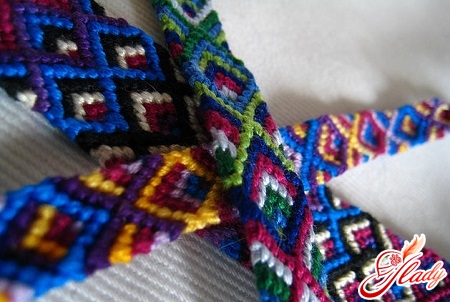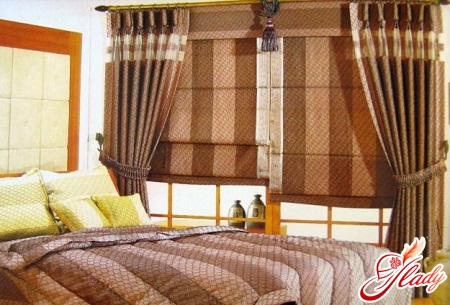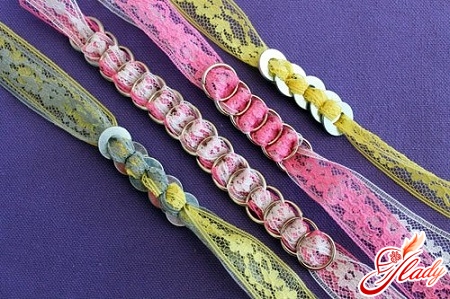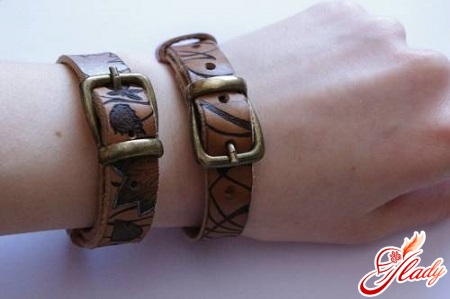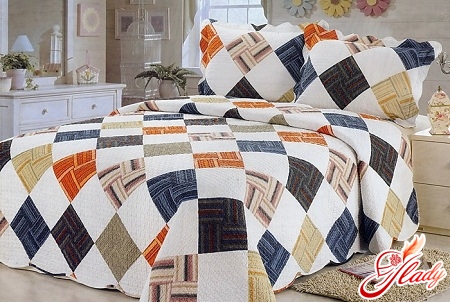 Do you have a desire to create something with your own hands?patchwork masterpiece? Well, it's quite an understandable desire. After all, bedspreads, blankets, pillowcases, tablecloths and other home textiles created using the patchwork technique can become an exclusive decoration of the interior. They will not only decorate your home, but will add a unique flavor, special comfort and warmth to it. In addition, not only aces of patchwork sewing, but even beginner quilters can sew such an exclusive with their own hands. However, even if you are not going to seriously take up patchwork sewing, but just know how to stitch on a machine, you can also master a patchwork bedspread. So, let's get started.
Do you have a desire to create something with your own hands?patchwork masterpiece? Well, it's quite an understandable desire. After all, bedspreads, blankets, pillowcases, tablecloths and other home textiles created using the patchwork technique can become an exclusive decoration of the interior. They will not only decorate your home, but will add a unique flavor, special comfort and warmth to it. In addition, not only aces of patchwork sewing, but even beginner quilters can sew such an exclusive with their own hands. However, even if you are not going to seriously take up patchwork sewing, but just know how to stitch on a machine, you can also master a patchwork bedspread. So, let's get started.
Tools and materials
In order to sew a patchwork with your own handsTo make a bedspread, you will need, first of all, scraps. For a bedspread measuring one and a half meters by two meters thirty centimeters (standard size), you will need sixty square scraps with a side of twenty-three centimeters. In addition, you will need a piece of cloth (1.5 x 2.3 m), which will become the back of the bedspread, and a padding polyester (lining) measuring one meter thirty by two hundred. Also prepare threads of two colors: the color of the back and the color of the leading (dominant) scrap. Tools needed for sewing the bedspread: sewing needles or pins, a sewing machine, scissors or a rotary cutter.
Selection of flaps
It is not difficult to sew a bedspread with your own hands. It is more difficult to select patches for it in a matching color scheme. A patchwork blanket can be made two-color or multi-color.
- Two-color version
For such a bedspread you select thirtyscraps of a solid pastel color and thirty dark scraps. If you want to use printed fabrics in your work, then the scraps with a pattern should be lighter, and it is advisable to choose a small pattern. What color combinations can be used? Here are some interesting options: lemon and light brown (caramel color), milky pink and burgundy, ivory and dark chocolate. As for the texture of the fabric, it can be any, but the density and thickness of the scraps should be the same.
- Multi-color option
For a multi-colored bedspread, we select scrapsdifferent colors. However, experienced patchwork makers recommend choosing fabrics of no more than seven different colors for a multi-color patchwork quilt. Moreover, only one type of patch can be the leading one. That is, the number of such patches should be greater than the rest. Thus, if you are sewing a quilt from sixty pieces of fabric, then there should be at least twenty-five leading patches. Calculate the number of other patches depending on the pattern, and select the color scheme empirically.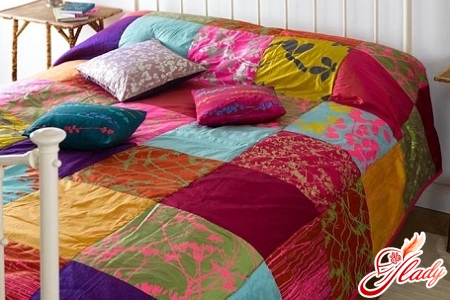
Manufacturing process
Sew a patchwork quilt with your own handsso easy that even a beginner can handle it. True, you need to be patient: the process is still labor-intensive. First, you need to prepare the fabrics for work: subject them to decatization. That is, you need to soak (or wash) the canvases, and then iron them thoroughly. If you are working with cotton fabrics, it is also advisable to starch them, and hold silk in a gelatin solution. This will give the fabrics some rigidity, and it will become much more convenient to work with them. And do not forget to check the correspondence of the needle on the sewing machine to the selected fabric and make test stitches, adjusting the thread tension. Now we proceed to the process itself. Take two patches of different colors, fold them with the front sides and stitch, stepping back from the edge by one and a half centimeters. Then sew another patch to these two and so, alternately changing colors, stitch a strip of six squares. Then sew nine more such strips and iron the seams, ironing the allowances in the opposite directions from the stitching. The next step will be stitching the strips. Fold two strips with the wrong sides outward, pin them (so that they do not come apart) and stitch on one side, stepping back one and a half centimeters from the edge. When folding the strips, make sure that the squares are staggered. And so connect all the strips into a single piece, and then iron all the new seams again. Next comes the lining's turn. Place the patchwork fabric sewn (with your own hands!) face down, and lay the padding polyester on it. The size of the padding polyester will be larger than that of the sewn fabric (part of the fabric went into the seam allowances). Therefore, lay out the padding polyester so that it protrudes beyond the fabric equally from all sides, and pin both parts together. Now, along all the lines (squares and stripes on the patchwork panel), sew the padding polyester to the panel, trying to get exactly into the seams. As a result, we will get a beautiful square stitch. Place the quilted parts (wrong side to wrong side!) on the panel prepared for the back side of the blanket. As in the case of the padding polyester, all the protruding edges of the panel should be the same. Then pin the parts and baste. Now fold the protruding edges of the back panel down by one and a half centimeters and baste them. Then fold the two opposite edges of the bottom panel inside out by one and a half centimeters again, baste and stitch. Do the same with the two remaining edges of the panel. Hem the corners by hand. That's how you can sew a beautiful patchwork blanket with your own hands. This is one of the simplest patterns, but you can also come up with or find other patterns, choosing a more complex ornament. You can also use old denim items for the bedspread and, cutting out scraps from them, make a bedspread using the patchwork technique.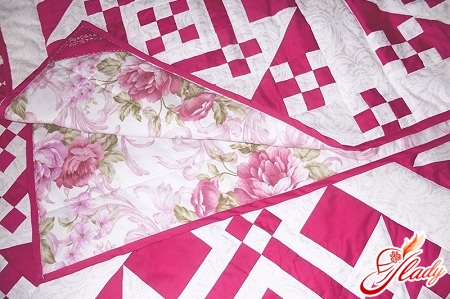
Bedspread from jeans flap
Do it yourself any old jeans, denimюбки, куртки и сарафаны можно превратить в оригинальное и долговечное покрывало. Для того чтобы сшить такое креативное изделие, вам понадобится только джинса и ткань для изнанки. И что интересно, покрывало получится лоскутным с обеих сторон! Итак, наводим ревизию в шкафах и достаем из их недр любые старые джинсовые вещи. Для изнаночной стороны подойдут практические любые ткани, главное, чтобы их плотность была примерно одинаковой. Размер элементов для своего покрывала определяйте самостоятельно, исходя из величины остатков ткани, которую собираетесь использовать в работе. Из джинсов и подкладочной ткани нарежьте квадратных лоскутов и рассортируйте их попарно: джинсовый лоскут и лоскут из вспомогательной ткани. Сложите все пары изнаночными сторонами и приступайте к работе. Возьмите две пары лоскутов и сложите их друг на друга подкладами внутрь, джинсовой тканью наружу. Подравняв края, отступите от кромки полтора-два сантиметра и сострочите эту стопочку квадратиков по одной из сторон. Теперь разверните ее, разъединив две пары лоскутов. У вас получилась деталь будущего полотна. Припуск для шва должен оказаться с лицевой стороны будущего покрывала, а ровный соединительный шов – с изнанки. Таким образом сшейте все подготовленные пары, после чего получившиеся детали сострочите в целое полотно желаемого размера. В завершение прострочите все покрывало по краям, также отступив полтора-два сантиметра. Эту отстрочку можно сделать двойной (шов в шов). Если вы думаете, что самая кропотливая часть работы завершена, то спешим вас разочаровать – самое муторное еще впереди. Теперь вам понадобятся очень острые ножницы, способные прорезать четыре слоя ткани, а именно такие припуски у нас остались с лицевой стороны покрывала. Делаем надрезы от края припуска до шва по всей поверхности полотна и по его краям. Разрезаем припуски аккуратно, не доходя до шва несколько миллиметров и делая рассечки через полтора-два сантиметра. После чего руками теребим порезанную ткань, дав ей немного распушиться. И заключительным этапом станет расчесывание нашего покрывала. Для этого понадобится жесткая металлическая щетка (например, щетка для животных). Этой «чесалкой» нужно продрать каждый шовчик, вычесывая поперечные нити и распушая продольные. Работа, конечно, занимает много времени, но результат того стоит! Покрывало будет выглядеть потрясающе, а вдобавок к этому прослужит очень долго. Все квадратики лоскутного полотна получатся окаймленными рукотворной бахромой, которая со временем слегка сваляется и накрепко «законсервирует» швы. Если вариант с бахромой по краям покрывала вам не нравится, то попробуйте обвязать их с помощью крючка. Но все-таки бахромчатые края такого покрывала будут выглядеть куда эффектнее. Сшитое своими руками покрывало в стиле пэчворк станет отличным украшением интерьера. Да и практическая польза от него тоже будет (как, впрочем, от любого другого покрывала). А вы с чувством глубоко удовлетворения результатом своей работы можете беспрестанно любоваться этим творением. Или же, войдя в раж, приступите к освоению все новых и новых техник лоскутного шитья. Поверьте, пэчворк – занятие азартное: раз начав, остановиться трудно. Но это полезное увлечение, поэтому не бойтесь заразиться и смело делайте первый шаг. Удачи! Советуем почитать:





